11. Implications and applications¶
This week I worked on defining my final project idea and started to getting used to the documentation process.
O Meu Mondo Research¶
The project aims to take the soft toy industry by storm by creating eco-conceived plush toys for multicultural children and guardians of the earth.
O Meu Mondo shows that it is possible to create plush toys through distributed manufacture, using digital tools; using regenerative materials and pigments, and generative design principles. This means that make/teach/do principles are applied to ignite the human spirit to collectively problems solve and apply solutions to a plethora of different contexts.
Because multiculturality is a richness to be celebrated, and our children deserve better toys!
Within the next three months, the project will test different materials to be used as substitutes to the polyester currently used. 60% of textiles produced are made from synthetic fibers, therefore out of plastic and fossil fuels. Most plush toys are made of polyester ( = plastic), at best-recycled polyester (overall 18% of textiles are recycled). With each load of wash, 700,000 microscopic plastic fibers are released into wastewater. They pollute the environment, harm ecosystems, and end up in our food and drinking water.
The project will test natural pigments and bacterial dyes in order to translate the best look and feel.
We will also experiment with open-source-zero waste pattern making, and test e-textiles onto our toy. The idea is that parents, using Arduino can light up the zones of the world where they have left their hearts, or that represent their genetic origins. This a personalized 23 and me toy, which can grow with the child. The parents can teach the child how to code and light up the areas of the world where he/she was lucky to travel and live.
Current market research¶
For my market research I sent out a survey, and got 5 answers for the form in French and 5 answers for the form in English. Here is the link to the English version:
I then conducted 6 one-on-one interviews were conducted with "ideal customer" types. In this sector, the respondents expressed the desire to find a balance between family life and professional life. My toy, bearer of values would help them to inculcate values so that their children can build themselves in a multicultural world, feeling that their origins are an additional wealth and that they belong to it.
Brainstorming on Miro¶
 Moodboard
Moodboard

Potential stakeholders¶
I used the Circulab Agency tools to map my potential stakeholders, using the following questions: * Who are the people impacted? * Who could cause trouble? * Who will be in charge? * Who has been in charge of similar projects? * Who can support such goals?
This process enables to map who could stakeholders be locally, nationally, and internationally concerning the design, manufacture, distribution, use, repair, take-back logistics, and end of life phases.
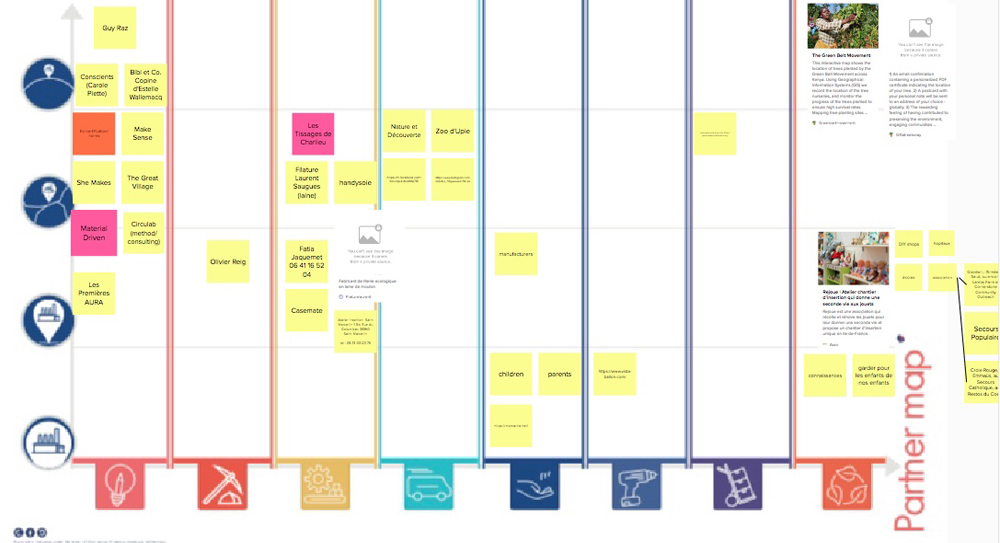
This process enabled me to spot that I have less stakeholders in the distribution phase, which is somewhat crucial for an open source and distributed manufacturing project. I was also able to identify local actors to help me with prototyping.
Concept¶
Here is the link to my presentation:
WHAT¶
 * Your key concept(s) / topics
Design for disassembly; distributed manufacture; open-source business models; agile manufacturing; generative design; regenerative design; distributive design; circular economy; manifesto; material research;
* is it a product? service? performance? platform?
Meu Mondo is a final product available for sale. But it is also open-source building plans, assembly instructions, and bill of materials, as well as workshops to help people make their own.
* Your key concept(s) / topics
Design for disassembly; distributed manufacture; open-source business models; agile manufacturing; generative design; regenerative design; distributive design; circular economy; manifesto; material research;
* is it a product? service? performance? platform?
Meu Mondo is a final product available for sale. But it is also open-source building plans, assembly instructions, and bill of materials, as well as workshops to help people make their own.
HOW¶
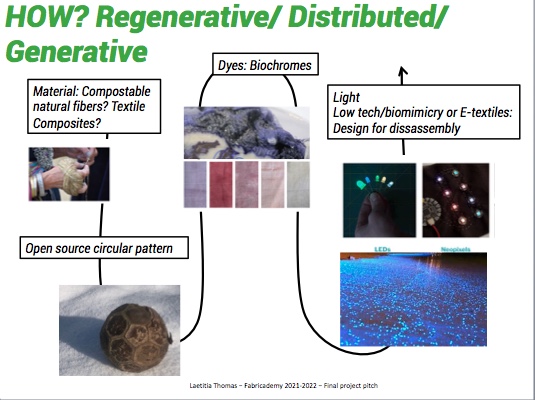 From the Fabricademy courses we've taken, I think that the ones that would be most suited for my project would enable me to explore:
From the Fabricademy courses we've taken, I think that the ones that would be most suited for my project would enable me to explore:
- material and dye alternatives
- upcycling fabric waste
- exploring bacterial dyeing
- zero waste pattern making
- etextiles
WHY¶
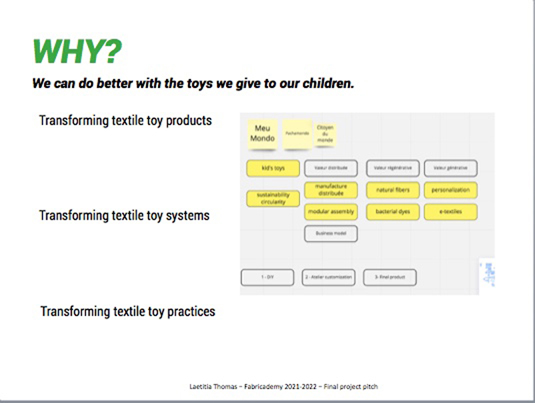
* This idea has been brewing in my head for a while. It started with having multicultural nephews and nieces and godchildren. I couldn’t offer a pale pink or pale blue toy to someone with origins spanning, France, the US, Africa and India! I made a collaborative mural in San Francisco about a multicultural child, with rainbow-colored wings. I then made a rainbow-colored wings quilt for my nephew. Years later he showed me his 23 and me results, continuously being updated on an app on his phone. The whole world lit up! He is literally 10% of most continents on this earth. I was amazed. Speaking about my aunt, he said “her map is just blue” since she mostly has English-isles origins.
From 2006 to 2011 I started my own brand, Chacha Chérie to create custom-made modern quilts for little citizens of the world. At that time I dreamt of studying at Eindhoven or the Royal College of the Arts. But beyond beautiful designs, I wanted to make eco-conscious ones as well. I dove into research, and wrote my MBA thesis on “the future of the textile industry and how to mainstream sustainable change in the French textile supply chain”. This led to more research, and I wrote my Ph.D. thesis on “Open Source Hardware Business Models”. How do we create conscious products that change patterns of consumption and production for a positive social and environmental outcome? How can we collaborate in order to spread impact? How do we change the level of consciousness of industry to elevate it to a regenerative model, where we co-create with nature? These have been the questions I have tried to resolve. Charles Eisenstein’s quote “by listening to what calls for our care (and brings us joy, and enables us to serve through our talents).
* is there a larger cause you are contributing to?
WHEN¶
Following my plan I need to work on:
* material selection for the background fabric, filling, applique fabric (linen, hemp, organic cotton jersey blend)
* explore biochromes (natural dyes and bacterial dyes)
* explore zero-waste pattern making
* learn how to use the embroidery machine & laser cutter to speed up my process.
* e-textiles (see how I can make my Meu Mondo interactive)
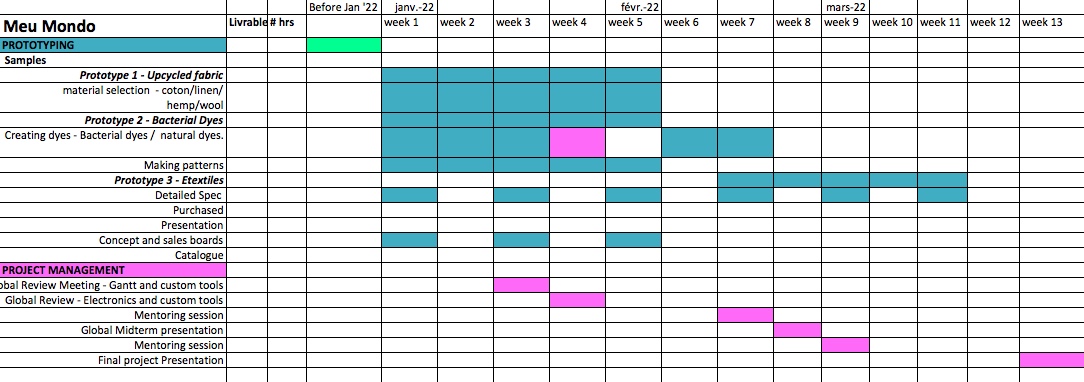
Idea 1 Upcycled fabric method¶
My colleague Surzhana Radnaevas shared her method for producing new fabric from scraps. I find this method extremely useful, since most designers have tons of left over fabrics. This is really a simple method to learn to "start with what you have" in order to reduce textile waste.
I'm experimenting with this as my son asked for a giant dinosaure for Christmas, which I could make from all my left over scraps.
Paragraph:
- Step 1: Lay all fabric scraps on backing. In my case I used single face iron-on-interface.
 - Step 2: Add background fabric. In my case I used an old sheet, but I found that I can just quilt the pieces on the interface as well.
- Step 2: Add background fabric. In my case I used an old sheet, but I found that I can just quilt the pieces on the interface as well.
 - Step 3: Add mesh and quilt together.
- Step 3: Add mesh and quilt together.
Surzhana added a mesh such as tulle. I want to keep the softness of the fabric, so I simply quilted the pieces together.
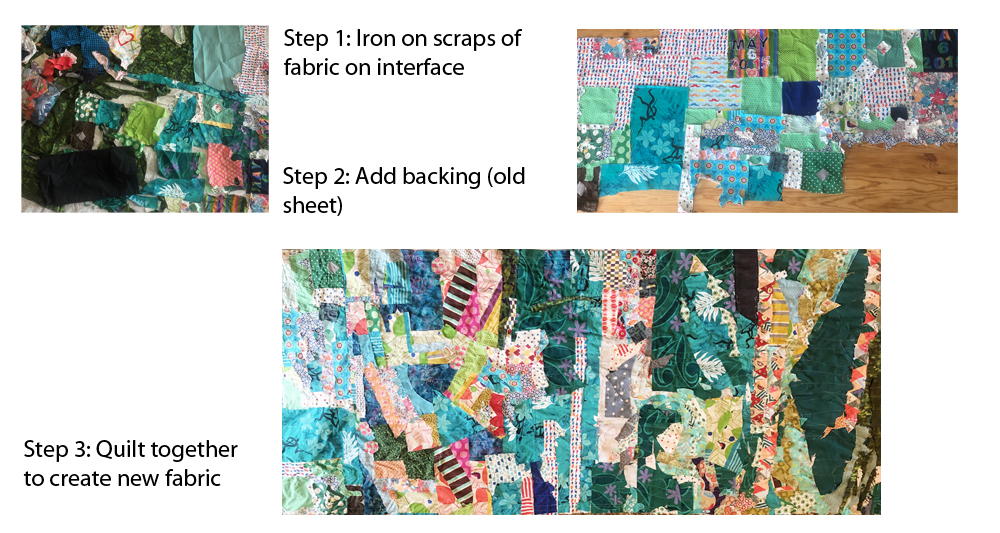
There so many options available. I could also try to gellify my upcycled fabric and turn it into something more rigid that I could laser cut, to make continents for instance.
Research shows that children are naturally attracted to brighter colors, because their eyes are not fully developed yet. Therefore I decided to make upcycled fabric out of all my primary color scraps: in red, yellow, blue, and green.

Useful links¶
- Circular Economy
- Markdown
- [Children are attracted to brighter colors] (https://sciencing.com/do-bright-colors-appeal-kids-5476948.html)
- [Color theory in kids terms] (https://sciencing.com/color-theory-kids-terms-5366742.html)
- Circulab Agency